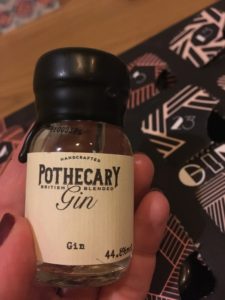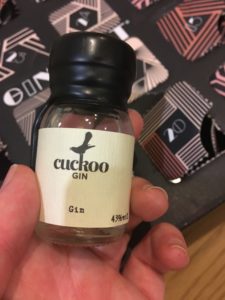 Happy Christmas Eve! It is with great sadness that we bring Ginvent to an end for yet another year, but before we do we need to try Scapegrace Gold gin. Scapegrace gin comes from New Zealand, when one guy married the other guy’s sister and discussed how they would like to make their own gin. 13 botanicals and a load of debt later, they had a gin that won gold in London and San Francisco. They use glacial water from the southern Alps mixed with orange and lemon peel, nutmeg, cloves and dried tangerine to make their classic 42% gin. Scapegrace Gold is their navy strength version at 57% which builds layers of citrus with orange, lemon and tangerine. So let’s see how it tastes.
Happy Christmas Eve! It is with great sadness that we bring Ginvent to an end for yet another year, but before we do we need to try Scapegrace Gold gin. Scapegrace gin comes from New Zealand, when one guy married the other guy’s sister and discussed how they would like to make their own gin. 13 botanicals and a load of debt later, they had a gin that won gold in London and San Francisco. They use glacial water from the southern Alps mixed with orange and lemon peel, nutmeg, cloves and dried tangerine to make their classic 42% gin. Scapegrace Gold is their navy strength version at 57% which builds layers of citrus with orange, lemon and tangerine. So let’s see how it tastes.
Ginvent 2018
Ginvent 2018 – Pothecary gin
 We’ve made it to the penultimate day of Ginvent. Sad face. Today we drink Pothecary gin, which I tried after meeting the team at Junipalooza earlier this year. You can read my thoughts on it here.
We’ve made it to the penultimate day of Ginvent. Sad face. Today we drink Pothecary gin, which I tried after meeting the team at Junipalooza earlier this year. You can read my thoughts on it here.
You can get your hands on a 50cl bottle from Gin Kiosk for £39 (at the time of writing). You can find them on Facebook, Twitter and Instagram.
Let me know your thoughts on Twitter and Instagram, and catch up with all things Ginvent here.
Ginvent 2018 – Malfy Gin
 Final three days! Today we drink Malfy gin, an Italian gin with a lovely label. Most accounts of gin history trace the roots back to the Dutch genever, but Malfy claim that gin was invented by monks on the Salerno coast and their distillery in Moncalieri has been established since 1906. The key flavour for Malfy gin is the Italian lemons that grow in Sicily and the Amalfi coast. These lemons give the gin it’s freshness, alongside Italian grown juniper and fresh spring water. Since launching, they have grown their range to include four varieties – the Originale that we are drinking today which actually came second and is more juniper forward than the original the Con Limone which makes the most of the fresh lemons, the Con Arancia using Sicilian blood oranges, and the Gin Rosa which features pink grapefruit and Italian rhubarb. So, how does it taste?
Final three days! Today we drink Malfy gin, an Italian gin with a lovely label. Most accounts of gin history trace the roots back to the Dutch genever, but Malfy claim that gin was invented by monks on the Salerno coast and their distillery in Moncalieri has been established since 1906. The key flavour for Malfy gin is the Italian lemons that grow in Sicily and the Amalfi coast. These lemons give the gin it’s freshness, alongside Italian grown juniper and fresh spring water. Since launching, they have grown their range to include four varieties – the Originale that we are drinking today which actually came second and is more juniper forward than the original the Con Limone which makes the most of the fresh lemons, the Con Arancia using Sicilian blood oranges, and the Gin Rosa which features pink grapefruit and Italian rhubarb. So, how does it taste?
Ginvent 2018 – Salcombe Start Point Gin
 With four days left to go, we’ve hit the third gin that I’ve already reviewed (this is impressive that we have so few this far in). Today’s gin is Salcombe Start Point gin, and you can read all my thoughts here.
With four days left to go, we’ve hit the third gin that I’ve already reviewed (this is impressive that we have so few this far in). Today’s gin is Salcombe Start Point gin, and you can read all my thoughts here.
You can get a 70cl bottle of the 44% gin from Gin Kiosk for £37.40 (at time of writing). You can find them on Facebook, Twitter and Instagram.
Let me know what you think on Twitter and Instagram, and don’t forget to keep up with all things Ginvent here.
Ginvent 2018 – Cuckoo Gin
 We’ve done remarkably to make it to 20 December before hitting another gin I’ve tried. Today’s gin is Cuckoo gin which I am a big fan of – you can read what I thought over here.
We’ve done remarkably to make it to 20 December before hitting another gin I’ve tried. Today’s gin is Cuckoo gin which I am a big fan of – you can read what I thought over here.
You can buy a 70cl bottle of 43% gin from Gin Kiosk for £38.00 (at time of writing). You can find Cuckoo on Facebook, Twitter and Instagram.
Have you tried Cuckoo gin? Let me know your thoughts on Twitter and Instagram. Don’t forget to keep up with all things Ginvent here.
Ginvent 2018 – Ramsbury Gin
 Ramsbury gin are one of the rare distilleries that have control of the whole process, from field to table. They grown their own wheat on their estate in Wiltshire and use their own chalk filtered water source. Sustainability is key – the heating in the distillery is generated by a biomass boiler, the livestock feed on the leftover wheat, and they clean their waste water with a reed bed system that is wildlife friendly. Before making gin, they started life as a brewery and used this knowledge to help make their gin what it is. They start by making their own vodka, which they then distil with nine botanicals (the usual suspects alongside some fresh quince) to make a gin they say is fruity and sweet with a floral note. So, is that really the case?
Ramsbury gin are one of the rare distilleries that have control of the whole process, from field to table. They grown their own wheat on their estate in Wiltshire and use their own chalk filtered water source. Sustainability is key – the heating in the distillery is generated by a biomass boiler, the livestock feed on the leftover wheat, and they clean their waste water with a reed bed system that is wildlife friendly. Before making gin, they started life as a brewery and used this knowledge to help make their gin what it is. They start by making their own vodka, which they then distil with nine botanicals (the usual suspects alongside some fresh quince) to make a gin they say is fruity and sweet with a floral note. So, is that really the case?
Ginvent 2018 – Dartmouth English Gin
 Today’s gin is one of the newer gins to the market as they only launched this year. Dartmouth English gin comes from the depths of Devon, using spring water from Calancombe alongside fresh herbs, flowers and fruit from the estate there. Their list of botanicals sounds like a good mix – juniper blended with floral notes (lavender, rosemary and some citrus) followed by warming spices (grains of paradise, cardamom and cubeb berries). Despite only launching this year, they have already been awarded “Gin of the Year 2018” by the Craft Distilling Expo from over 600 entrants from around Europe.
Today’s gin is one of the newer gins to the market as they only launched this year. Dartmouth English gin comes from the depths of Devon, using spring water from Calancombe alongside fresh herbs, flowers and fruit from the estate there. Their list of botanicals sounds like a good mix – juniper blended with floral notes (lavender, rosemary and some citrus) followed by warming spices (grains of paradise, cardamom and cubeb berries). Despite only launching this year, they have already been awarded “Gin of the Year 2018” by the Craft Distilling Expo from over 600 entrants from around Europe.
Ginvent 2018 – 209 Gin
 If you saw a full size bottle of 209 gin you’d recognise it instantly. One of the first craft gins on the scene, they launched in 2005 from San Francisco and are available in most supermarkets. They’ve since gone on to release an interesting range of gins – three of them are barrel aged in wine casks, giving them a sauvignon blanc, a chardonnay and a cabernet sauvignon. They also have a gin and vodka which are Kosher-for-Passover – one of the only spirits in the world overseen by The Orthodox Union to ensure the entire process meets the kosher dietary law. Their flagship gin differs to the norm, thanks to American definitions on gin theirs is less focused on juniper, and features citrus and floral notes with a touch of spice.
If you saw a full size bottle of 209 gin you’d recognise it instantly. One of the first craft gins on the scene, they launched in 2005 from San Francisco and are available in most supermarkets. They’ve since gone on to release an interesting range of gins – three of them are barrel aged in wine casks, giving them a sauvignon blanc, a chardonnay and a cabernet sauvignon. They also have a gin and vodka which are Kosher-for-Passover – one of the only spirits in the world overseen by The Orthodox Union to ensure the entire process meets the kosher dietary law. Their flagship gin differs to the norm, thanks to American definitions on gin theirs is less focused on juniper, and features citrus and floral notes with a touch of spice.
Ginvent 2018 – Faith & Sons Mango Gin
 I’m starting this with a bold statement: today’s gin will either be disgusting, or delicious. I don’t think there’s going to be an in between. Why? Today we try Faith & Sons mango gin. I like mango. I like gin. But I am not sure if I want the two together. Faith & Sons puree their organic mangoes which are then added to their (also organic) spirit, meaning they use no artificial flavours or colours. Regardless of the flavour, I am massively in love with the Manchester based distillery’s labels and square bottles. So, do we love it or loathe it?
I’m starting this with a bold statement: today’s gin will either be disgusting, or delicious. I don’t think there’s going to be an in between. Why? Today we try Faith & Sons mango gin. I like mango. I like gin. But I am not sure if I want the two together. Faith & Sons puree their organic mangoes which are then added to their (also organic) spirit, meaning they use no artificial flavours or colours. Regardless of the flavour, I am massively in love with the Manchester based distillery’s labels and square bottles. So, do we love it or loathe it?
Ginvent 2018 – Hayman’s Royal Dock gin
 Hayman’s make good gin. Blanket statement. I hope. I’ve tried their London Dry, Sloe and Old Tom gins, and today we try their Royal Dock. This is bottled at 57% ABV, traditional for Navy Strength gin and they still use the same recipe that was used in 1863 when they supplied the gin to the English Admiralty. The higher ABV allows the juniper to shine through, accompanied by notes of citrus, coriander and a hint of subtle spice.
Hayman’s make good gin. Blanket statement. I hope. I’ve tried their London Dry, Sloe and Old Tom gins, and today we try their Royal Dock. This is bottled at 57% ABV, traditional for Navy Strength gin and they still use the same recipe that was used in 1863 when they supplied the gin to the English Admiralty. The higher ABV allows the juniper to shine through, accompanied by notes of citrus, coriander and a hint of subtle spice.